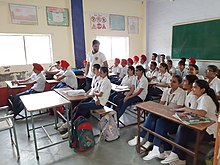
Students can develop a positive outlook on themselves and others through social emotional learning activities. This helps them become better citizens and learners. These activities produce long-lasting benefits that can be used as an educational tool by students in many environments. Teachers can use social emotional learning programs for their students to improve the school's environment, regardless of whether they are in elementary, middle or high school.
To start your program, you need to get to know your students. Watch their expressions and behavior. Understand their relationships with other students and at home. You can begin to identify small cues, like facial expressions, which show that they need practice in social skills.
First, identify the types of emotions that can arise in class. For example, you might experience sadness, anger, or confusion in class. Talk to students about how to deal with these emotions. Ask them for a list of their most frequent feelings. Also, ask them to name the words they use.

Then, you can create an emoji chart, so students can easily recognize their emotions. It is also a good idea, to print out a number of cards. These cards include words and pictures that depict different emotions. Students can use the cards to track their moods by sticking them on their ring.
Role-play scenarios can be another option. Students can take part in role-play scenarios, such as when they are reading a story. They could walk around the room and make a face representing one of their emotions. Encourage them to search for a friend that they feel close to. This will allow them to explore the ways they feel about a particular color or character.
Twinkl's digital resources (e.g. a tablet/computer) can be used to access Twinkl’s social and emotionally learning activities. The company has a wide selection of social and emotional learning tools, which are downloadable in PDF format. These worksheets may be used for instruction or independent work. Twinkl digital tools will allow you to teach social, emotional and communication skills to your students.
Your students can be encouraged to create their own stories by you as you work with them. This will allow them to understand empathy and how it can be beneficial for the classroom. Storytelling will also help your students learn vocabulary and comprehension skills.

Students will be able to build an emotional tower in support of academic success by including these types activities into their curriculum. Students will learn how to manage emotions, make healthy choices and develop strong relationships with their classmates. You will increase academic productivity and improve the cultural environment in your classroom.
You can also teach students about empathy by incorporating random acts of kindness into the classroom. This can be done by having students check in on a daily basis or holding a morning meeting. Students can build friendships in and out of the classroom when they show kindness to one another. In addition, the students will learn the value of being kind and the positive impact that it can have on the community.
FAQ
Should I choose to specialize in a single subject or branch out into other areas?
Many students choose to specialize in one subject (e.g., English, History, Math) instead of branching into multiple subjects. It's not necessary to be a specialist. You could, for example, choose to specialize in surgery or internal medicine if you are considering becoming a physician. You could also choose to specialize in family practice, pediatrics, gerontology or neurology. If you are considering a career in the business world, you might focus on marketing, sales, finance, operations research, marketing management, and human resources. The choice is yours.
What is an alternate school?
The idea behind an alternative school is to offer students with learning difficulties access to education by providing them with support from qualified teachers who understand their individual needs.
Alternative schools exist to offer children with special educational requirements the opportunity to learn in a normal classroom environment.
In addition, they are also given extra help when needed.
An alternative school isn't only for those who have been expelled from mainstream schools.
They are open to all children regardless of ability or disability.
What is a trade school?
Trade schools provide an alternative pathway for students who have not achieved success at traditional higher educational institutions to earn a college degree. They offer career-oriented programs that help students get prepared for specific careers. These programs allow students to complete two years' worth of coursework in one semester. Then they can enter into a paid apprenticeship program that teaches them a specific skill set and provides on-the job training. Trade schools can be classified as vocational schools or technical colleges. Some trade schools also offer associate degrees.
Is it hard to be a teacher?
Being a teacher is a huge commitment. You will need to devote a significant amount of time to your studies.
While completing your degree, you can expect to work approximately 40 hours per week.
A job that is flexible with your schedule is another important consideration. Many students have difficulty finding part-time work that allows them to balance schoolwork and their personal lives.
You will likely teach classes once you have been hired as a full time teacher. You may also need to travel between schools each week.
Statistics
- And, within ten years of graduation, 44.1 percent of 1993 humanities graduates had written to public officials, compared to 30.1 percent of STEM majors. (bostonreview.net)
- Data from the Department of Education reveal that, among 2008 college graduates, 92.8 percent of humanities majors have voted at least once since finishing school. (bostonreview.net)
- Globally, in 2008, around 89% of children aged six to twelve were enrolled in primary education, and this proportion was rising. (en.wikipedia.org)
- “Children of homeowners are 116% more likely to graduate from college than children of renters of the same age, race, and income. (habitatbroward.org)
- Think of the rhetorical power of nineteenth-century abolitionist Harriet Beecher Stowe, Martin Luther King, Jr., or Occupy Wall Street activists with their rallying cry of “we are the 99 percent.” (bostonreview.net)
External Links
How To
What is vocational training?
Vocational Education, which is an educational system that prepares high school students for jobs after college or high school, provides them with training in specific skills required for a job (e.g. welding). It includes training on the job in apprenticeship programs. Vocational education differs from general education because it focuses on preparing individuals for specific careers rather than learning broad knowledge for future use. Vocational education does not prepare students for university, but it helps them find work after graduation.
Vocational education is available at all levels of education, including primary, secondary, high school, college, universities, technical institutes as well as trade schools, community colleges and junior colleges. In addition, there are many specialized schools such as culinary arts schools, nursing schools, law schools, medical schools, dental schools, veterinary medicine schools, firefighting schools, police academies, military academies, and other military schools. Many of these schools offer both academic instruction and practical experiences.
In recent decades, many countries have made large investments in vocational training. The effectiveness of vocational training is still a controversial topic. Some critics claim it is not effective in improving students' employability. Others argue that it helps them prepare for life after school.
The U.S. Bureau of Labor Statistics has estimated that 47% of American adults hold a postsecondary certificate or degree related to their current occupation. This number is higher for those with higher education. 71% of 25-29-year-olds have a bachelor's or higher degree and are employed in areas that require postsecondary credentials.
In 2012, the BLS reported that nearly half of the nation's adult population had at least some form of postsecondary credential. A third of Americans have a two-year associate's degree and 10% hold a four year bachelor's degree. One in five Americans holds a master’s degree or doctorate.
The median annual salary for people with a bachelor's was $50,000. This compares to $23,800 for those who don't have a degree. For those with advanced degrees, the median wage was $81,300.
The median income for those who have not completed high school was just $15,200. The median annual income for those with less than a high-school diploma was $13,000